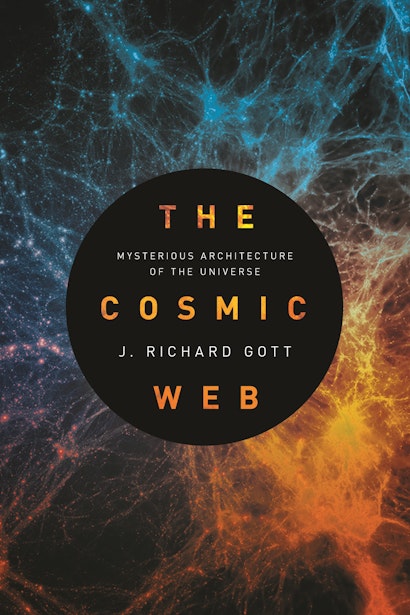J. Richard Gott was among the first cosmologists to propose that the structure of our universe is like a sponge made up of clusters of galaxies intricately connected by filaments of galaxies—a magnificent structure now called the “cosmic web” and mapped extensively by teams of astronomers. Here is his gripping insider’s account of how a generation of undaunted theorists and observers solved the mystery of the architecture of our cosmos.
The Cosmic Web begins with modern pioneers of extragalactic astronomy, such as Edwin Hubble and Fritz Zwicky. It goes on to describe how, during the Cold War, the American school of cosmology favored a model of the universe where galaxies resided in isolated clusters, whereas the Soviet school favored a honeycomb pattern of galaxies punctuated by giant, isolated voids. Gott tells the stories of how his own path to a solution began with a high-school science project when he was eighteen, and how he and astronomer Mario Jurič measured the Sloan Great Wall of Galaxies, a filament of galaxies that, at 1.37 billion light-years in length, is one of the largest structures in the universe.
Drawing on Gott’s own experiences working at the frontiers of science with many of today’s leading cosmologists, The Cosmic Web shows how ambitious telescope surveys such as the Sloan Digital Sky Survey are transforming our understanding of the cosmos, and how the cosmic web holds vital clues to the origins of the universe and the next trillion years that lie ahead.
Awards and Recognition
- Winner of the 2017 PROSE Award in Cosmology & Astronomy, Association of American Publishers
- One of Symmetry Magazine’s Physics Books of 2016
"With an insider's insight and a storyteller's eye for detail. . . . Gott offers a thorough, vivid, and fascinating look at the cosmic web that makes up our universe."—Publishers Weekly
"The Cosmic Webis not just a well-told story about the frontiers of cosmological knowledge. It is also an inspiration to explore them further."—Michael Blanton, Nature
"Weaving together personal anecdotes with physics and math, Princeton astrophysicist J. Richard Gott's The Cosmic Web chronicles the nearly 100-year quest to understand the anatomy of the universe. . . . Gott brings detailed insight to how our view of the cosmos has changed, providing a thorough accounting of how cosmologists arrived at these revelations."—Christopher Crockett, Science News
"Provides an outstanding summation of [Gott's] search for understanding the spongy cosmic web that characterizes the universe at large scales. . . . [A] magnificent achievement."—David Eicher, Astronomy Magazine
"With a style that's rich in fascinating detail, and bolstered by personal memories and anecdotes,The Cosmic Webdelivers everything we need in a book on this subject."—Alastair Gunn, BBC Sky at Night
"An extraordinary book guiding the reader through the large scale of the Universe and the structure scientists encounter whilst looking at the Universe as a whole."—Read about Science
"I enjoyed this book hugely. It should be on the shelf of anyone who is intrigued by why the Universe looks the way it does."—Alan Longstaff, Astronomy Now
"Full to the brim with wonderful analogies and genuinely interesting anecdotes that should be a component of all popular science books. If you've ever looked up at the night sky and wondered why it looks the way it does, this is one book you should really consider reading."—Amber Hornsby, Popular Astronomy
"Fascinating. . . . I think it should be in every library which aims to cover astrophysics and cosmology."—G.W. Gibbons, Contemporary Physics
"Always riveting and thought-provoking, Gott deftly drills down, tunneling through our spongelike universe to reveal wide vistas for contemplation."—Siobhan Roberts, author of Genius at Play: The Curious Mind of John Horton Conway
"If you're baffled by such things as dark matter, dark energy, and the curvature of space-time, help is at hand. J. Richard Gott is an eminent physicist who has made fundamental contributions to our understanding of the cosmos—but he also has a gift for expressing complex ideas in clear, compelling language. The Cosmic Web is a terrific guide to what astrophysicists know about the universe, what they don't know, and how they're searching for answers."—Michael D. Lemonick, author of Mirror Earth: The Search for Our Planet's Twin
"Cosmology fans and budding cosmologists will benefit from Gott's story of the personalities and ideas behind a century of discovery about our universe and its structure. We learn of Gott's role in the concept of the multiverse and many other aspects of modern cosmology—and, as he puts it, whether the universe resembles meatballs or Swiss cheese."—Jay M. Pasachoff, Williams College
"With lucidity and dry wit, Gott tells the story of how he and his colleagues mapped the large-scale structure of the universe, drawing together the physics of large and small in what must rank among the most significant scientific attainments of modern times. The Cosmic Web is easily accessible to general readers, but I'm betting that even cosmological aficionados will learn from it. Essential reading for everyone interested in how the cosmos got to be what it is today.—Timothy Ferris
"This is an excellent book written by a major contributor to the research on cosmic structure. Gott shows how theory, simulations, and galaxy redshift surveys combine to give us a detailed understanding of the ‘cosmic web,' and convincingly describes how our knowledge has advanced as computation and observational capabilities have improved."—Chris Impey, coauthor of Dreams of Other Worlds: The Amazing Story of Unmanned Space Exploration
"By going beyond a sort of ‘Cosmology 101' pseudo-history. . . Gott provides a complement to this more conventional story, artfully recounting the excitement, debates, and false directions that led to our current ‘best bet' theoretical description of the universe."—Martin Bucher,Physics World
"Not only do astronomers know the extent and content of the universe, they know where it all came from. . . . It is a picture of our universe that previous generations would have killed for. Gott describes all of this with clarity, charm and infectious enthusiasm. . . . Excellent."—Marcus Chown,Times Higher Education


